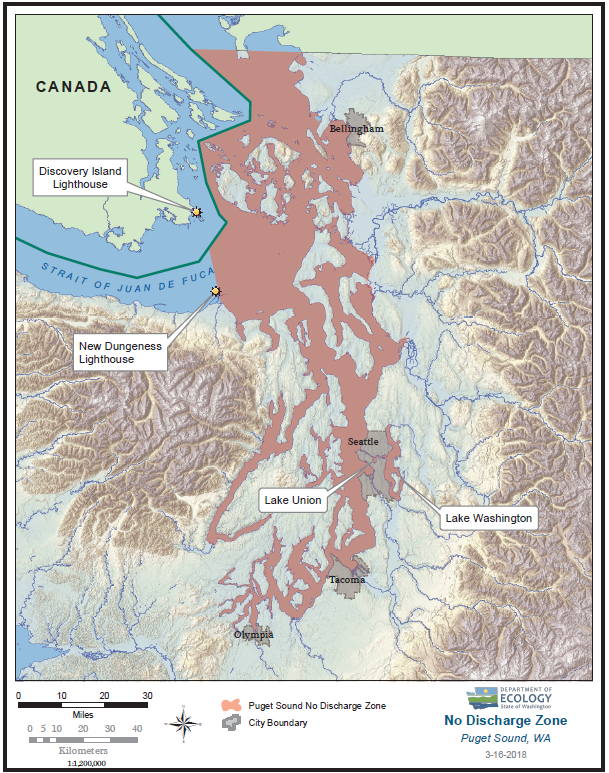Puget Sound is now a no-discharge zone for vessel sewage
We have established a Vessel Sewage No Discharge Zone (NDZ) for Puget Sound and certain adjoining waters. The NDZ is a body of water where boats may not release sewage, whether treated or not. It helps protect public health, water quality, and sensitive resources.
The NDZ (Chapter 173-228 WAC) was adopted on April 9, 2018, after a five year public process and approval from the Environmental Protection Agency (EPA). The rule was effective May 10, 2018. However, certain commercial vessels had a five year delay before the rule begins, they now must follow the rule. There is no change for graywater discharges.
Protecting sensitive resources safeguards public health and the economy
Even small amounts of sewage discharges over or near shellfish beds can cause enough pollution to require harvest closures. Puget Sound is a unique and sensitive environment that is prone to poor water quality conditions. A no discharge zone addresses this source of preventable pollution from impacting shellfish beds, beaches, and water quality.
The Vessel Sewage NDZ fills a missing piece in the state’s Puget Sound Action Agenda and is part of other larger investments in sewage treatment: on-site septic systems, stormwater management, and agricultural runoff control. The Puget Sound Partnership has identified a NDZ as a key action for the Shellfish Restoration initiative in the Action Agenda. Although this is the first NDZ in Washington, more than 90 NDZs exist in 26 states to address pollution problems.
Boaters like you can help us make a difference for Puget Sound
Washington boaters already practice good stewardship of state waters. The vast majority of vessels have holding tanks for use at pumpout facilities or to hold their sewage (blackwater) until they reach the ocean for discharge. Help us keep Puget Sound sewage free, see our recreational boating resources or our commercial vessel resources for more information.
Map of the no discharge zone
The Vessel Sewage No Discharge Zone includes all Washington marine waters east of New Dungeness Lighthouse, at the east end of the Strait of Juan de Fuca, plus Lake Washington, Lake Union, and the waters that connect them to Puget Sound.
Recreational boating resources
The vessel sewage rule is effective as of May 10, 2018 for all recreational boats, and was adopted on April 9, 2018.Most recreational boats already have holding tanks and boaters are now not allowed to discharge sewage, treated or untreated, into Puget Sound. If your boat has a toilet on board, you are required to have a marine sanitation device (MSD).
- If you have a treatment MSD (Type I or Type II), you will need to secure it in a manner which prevents discharge of treated or untreated sewage. See the Coast Guard regulations for more details. Acceptable methods of securing the device include:
- Closing the seacock and removing the handle
- Padlocking the seacock in the closed position
- Using a non-releasable wire-tie to hold the seacock in the closed position
- Locking the door to the space enclosing the toilets with a padlock or door handle key lock
- If you have a toilet with a holding tank (Type III MSD) you can use the variety of pumpout facilities to pump out your sewage (see links below).
- Vessels without installed toilets must dispose of any collected sewage from portable toilets or other containment devices at facilities in a manner that complies with state law (ashore in proper facility). Don’t dump it in the water.
Where to dispose boat sewage
You can use stationary pumpouts, mobile pumpout boats, pumping services (trucks, barges), or discharge outside the NDZ following state requirements.
Find a pumpout in Washington or visit the State Parks pumpout website.
Enforcement
Our approach is first focused on outreach and education. We are working with partners in an NDZ Enforcement Committee and NDZ Outreach and Education Committee to help spread the word about our new rule.However, it’s the law. Your sanitation device may be inspected and you could be fined. Ecology and the United States Coast Guard may enforce this rule by using any of the enforcement provisions in Washington's water pollution control act or other federal provisions. In addition, other federal, state, and local agencies may provide enforcement, as authorized.
Related links
Contact information
Amy Jankowiak
No Discharge Zone Project Lead
amy.jankowiak@ecy.wa.gov
425-429-4259
Evan Dobrowski
No Discharge Zone Compliance Specialist
evan.dobrowski@ecy.wa.gov
425-213-4230


